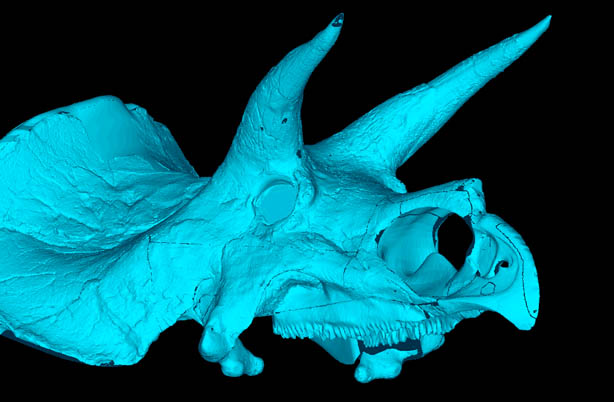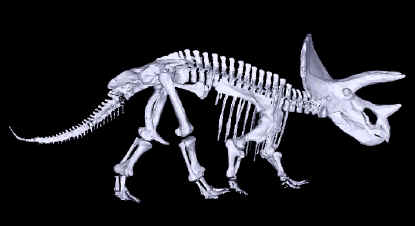Scientific Modeling
During the last decade, we have been working with
scientists from around the world on a variety of programs requiring
the use of 3-D scan data. Most interesting is our work with
vertebrate paleontologists – those who study extinct animals.
The
Dinosaurs
For several years Virtual Surfaces Inc. has worked closely with
paleontologists at the
University
of Chicago, The
Smithsonian's National Museum of Natural History and National
Geographic Magazine. Our goal is to develop and use industrial
three-dimensional techniques in the study of fossil and/or
biological specimens. Our experience includes working with CT,
laser, optical, and CGI scanners. Unlike our Reverse Engineering
methods, which require NURBS (none uniform rational B-spline
surfaces), a biological entity, such as fossils, may have many
non-uniform surface features, and must be defined through a process
of point to point polygonalization. Polygonized data, usually as STL
(Stereolithography files) can be used for rapid prototyping, tool
path generation, dimensional analysis, digital comparisons and
graphical visualization and animation. Scan data can be transmitted
via the Internet to be studied by scientists around the world.
The Kennewick Man
Recently we had the opportunity to CT scan, edit and rapid prototype
the skull and hip bones of the
Kennewick
Man. The Kennewick Man was
discovered in 1996 near the town of Kennewick
WA, washing out of the bank of the Columbia
River. Radiocarbon dating indicated that he was about
9500 years old. Local Indian tribes claimed that because of his
great antiquity they should be given the rights to bury his remains
as per their custom. Scientists sued the Army Corps of Engineers
(COE) to obtain the rights to study such a perfect skeleton of such
great age.
After
years of court proceedings the scientists were finally allowed to
perform a series of
studies on the remains. One of these studies included the high
resolution CT scan of the skull and hip. The hip being important
because of a stone-age projectile point lodged in the Illium. Varian
performed the CT scanning
at their Lincolnshire, IL facility;
VSI performed the
digital editing and digital removal of
the projectile point. Harvest Technologies of Benton, TX provided
two sets of rapid prototyped bones and projectile point.
The
Kennewick Man’s physical dimensions can now be studied with no harm
to the original bones.
Scientific Modeling

Skull of a Triceratops created from 3-D scan data during the
Smithsonian's restoration project.
Smithsonian's all digital Triceratops.
Skull of Kennewick Man.

 office
(847) 797-5067
office
(847) 797-5067

